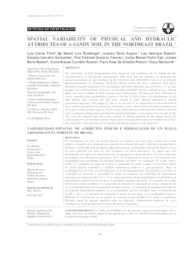Spatial variability of physical and hydraulic attributes of a sandy soil in the Northeast Brazil.
Spatial variability of physical and hydraulic attributes of a sandy soil in the Northeast Brazil.
Author(s): TIMM, L. C.; RECKZIEGEL, N. L.; AQUINO, L. S.; BASSOI, L. H.; GUIMARÃES, E. C.; TAVARES, V. E. Q.; VAZ, C. M. P.; MANIERI, J. M.; RAMOS, C. M. C.; RIBEIRO, P. R. de A.; REICHARDT, K.
Summary: The knowledge of field management zones based on soil attributes can be helpful for the implementation of site-specific management. This work had the objective of analyzing the spatial dependence of soil attributes of the 0-0.20 m and 0.20-0.40 m layers of an Entisols Quartzipsamments, in Petrolina, Northeast Brazil, which has been cultivated with micro sprinkler irrigated grapevines. In a rectangular grid with 168 points spaced by 4.0 x 3.5 m, soil samples were collected from each layer to determine soil bulk density, contents of clay, silt and sand, soil water contents at field capacity and wilting point. All data sets were submitted to classic statistical and geostatistical analyses. For the 0-0.20 m layer, the distributions of soil bulk density, clay content and soil water content at field capacity presented a spatial dependence structure, with ranges of 10.0 m, 8.3 m and 7.2 m, respectively. In the 0.20-0.40 m layer, spatial dependence was found for soil density, sand content (6.6 m for both attributes) and soil water content at field capacity (6.8 m range). Distributions of silt and sand contents and soil water content at wilting point presented no spatial dependence in the upper layer as well as the clay and silt contents and soil water content at wilting pointing in the deeper layer. By constructing the soil attribute contour maps, distinct management zones were defined as well as their extension. Practical uses for irrigation scheduling purposes were proposed.
Publication year: 2010
Types of publication: Journal article
Unit: Embrapa Semi-arid Region
Keywords: Atributos do solo, Dependência espacial, Irrigação, Neossolos Quartzarênicos, Solo, Uva
Observation
Some of Embrapa's publications are published as ePub files. To read them, use or download one of the following free software options to your computer or mobile device. Android: Google Play Books; IOS: iBooks; Windows and Linux: Calibre.
Access other publications
Access the Agricultural Research Database (BDPA) to consult Embrapa's full library collection and records.
Visit Embrapa Bookstore to purchase books and other publications sold by Embrapa.

